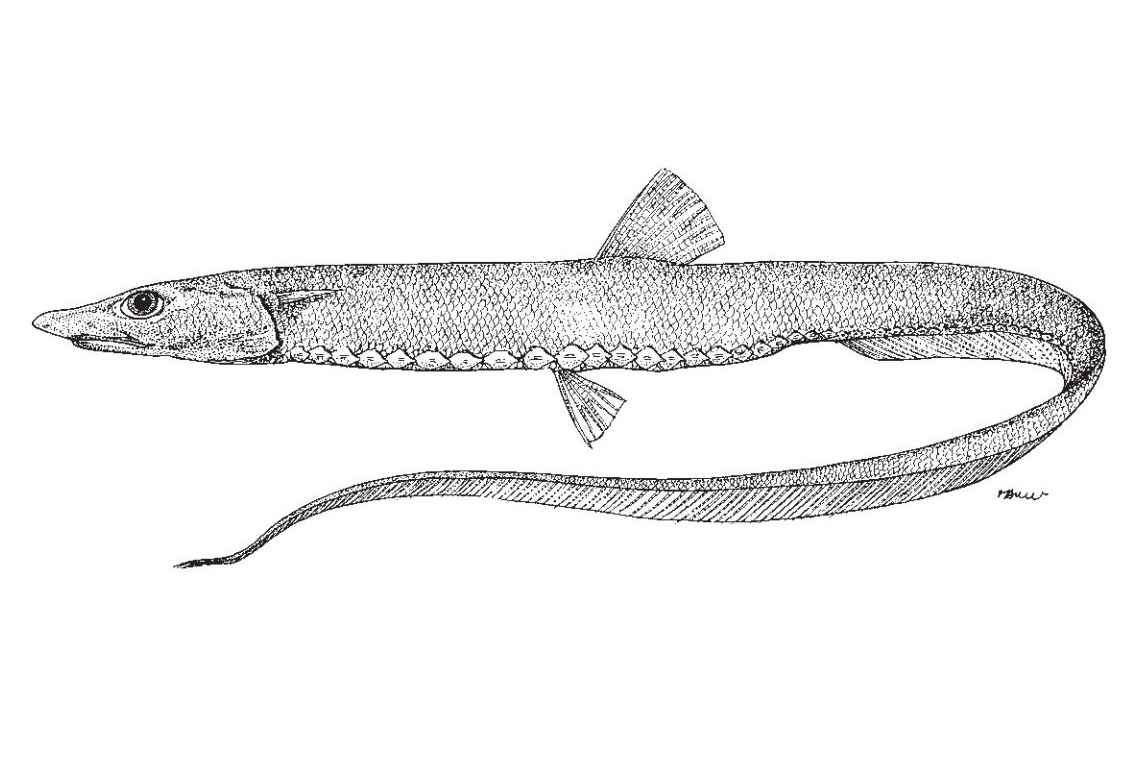Oily Halosaur, Aldrovandia oleosa Sulak 1977
Other Names: Bathyal Halosaur

Illustration of an Oily Halosaur, Aldrovandia oleosa. Source: Fig. in Smith (2016) in Carpenter & De Angelis (eds). The living marine resources of the Eastern Central Atlantic. Volume 3 / FAO. License: CC by Attribution-NonCommercial-ShareAlike
Summary:
A brown halosaur with a black head, a white anus surrounded by a ring of darkly pigmented tissue, and a black stomach, pyloric caeca, and peritoneum. Males have black tubular anterior nostrils and enlarged posterior nostrils when approaching breeding condition. The species has large lateral-line scales and oily skin.
Cite this page as:
Bray, D.J. 2022, Aldrovandia oleosa in Fishes of Australia, accessed 10 Jul 2025, https://fishesofaustralia.net.au/Home/species/5683
Oily Halosaur, Aldrovandia oleosa Sulak 1977
More Info
|
Distribution |
Balthazar seamount, SW of Christmas Island, eastern Indian Ocean. Elsewhere the species is circumglobal on the outer Continental Slope. |
|
Features |
Dorsal fin 10-11; Pectoral fin rays 9-11; Pelvic fin I,8-9; Gill rakers 19-23; Lateral line scales before anus 16-24; Gill Rakers 19-23 (total first arch); Branchiostegal rays: 9-11; Pyloric caecae 5-8. Body very elongate, moderately compressed; skin loose, oily; preoral portion of snout short, approx. one-third total snout length; mouth relatively small; palatine tooth patch well separated medially, widely separated from pterygoid tooth patch by a distance 1-4 times its length. Scales absent on top of head and opercle; lateral line scales two times larger than body scales, continuous with each other. Dorsal fin origin posterior to pelvic fin origin; first dorsal ray very short, vestigial. |
|
Size |
Maximum size: 52.0 cm TL; 16 cm preanal length. |
|
Feeding |
Feeds on polychaete worms |
|
Etymology |
The specific name is from the Greek oleosa (= oily), in reference to the yellowish oil in the flesh of this species. |
|
Species Citation |
Aldrovandia oleosa Sulak 1977, Copeia 1977(1): 12, Figs. 1, 2 left, 3 upper, 4 (A-C). Type locality: Tongue-of-the-Ocean, Bahamas, 23°38.5'-23°40.3'N, 76°47.75'-76°45.1'W, depth 1324-1307 m. |
|
Author |
Bray, D.J. 2022 |
|
Resources |
Oily Halosaur, Aldrovandia oleosa Sulak 1977
References
Kamikawa, D. & Stevenson, D. 2010. New records of Aldrovandia oleosa (notacanthiformes: Halosauridae) from the Eastern North Pacific Ocean. California Fish and Game 96: 216-220.
Smith, D.G. 2016. Halosauridae, Halosaurs pp. 1594-1600 in Carpenter, K.E. & De Angelis, N. (eds). The living marine resources of the Eastern Central Atlantic. Volume 3. Bony fishes part 1 (Elopiformes to Scorpaeniformes). FAO Species Identification Guide for Fishery Purposes. Rome, FAO. i-xiv + 1511-2350.
Sulak, K.J. 1977. Aldrovandia oleosa, a new species of the Halosauridae, with observations on several other species of the family. Copeia 1977(1): 11-20. https://doi.org/10.2307/1443498
Sulak, K.J. 1990. Halosauridae. pp. 126-132 in Quéro, J.-C., Hureau, J.-C., Karrer, C., Post, A. & Saldanha, L. (eds). Check-list of the Fishes of the Eastern Tropical Atlantic. Paris : UNESCO 1492 pp., 3 vols.
Tighe, K. 2015. Aldrovandia oleosa. The IUCN Red List of Threatened Species 2015: e.T190312A1947402. https://dx.doi.org/10.2305/IUCN.UK.2015-4.RLTS.T190312A1947402.en. Accessed on 13 September 2022.


